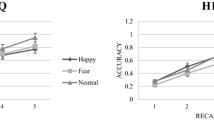Abstract
The present study pursued hypotheses relevant to prosodic abnormalities in the expressive language of autistic children. An operant paradigm was employed to measure the intrinsic reinforcing value of a verbally presented story for autistic, mentally retarded, and normal groups controlling for chronological age and performance mental age. Results suggested that both autistic and mentally retarded children could perceive prosodic cues, although only mentally retarded children are able to use them in their expressive language. It was also suggested that linguistic stimuli may have less intrinsic reinforcement value for autistic and mentally retarded children than for normal children. Implications for future research and treatment were discussed.
Similar content being viewed by others
References
Abercrombie, D. (1967).Elements of general phonetics. Chicago: Aldine.
American Psychiatric Association. (1980).Diagnostic and statistical manual of mental disorders (3rd ed.). Washington, D.C.: Author.
Aurnhammer-Frith, U. (1969). Emphasis and meaning in recall in normal and autistic children.Language and Speech, 12, 29–38.
Baltaxe, C. (1977). Pragmatic deficits in the language of autistic adolescents.Journal of Pediatric Psychology, 2, 176–180.
Baltaxe, C., & Simmons, J. Q. (1975). Language in childhood psychosis: A review.Journal of Speech and Hearing Disorders, 40, 439–458.
Baltaxe, C., & Simmons, J. Q. (198). Prosodic abnormalities in autism. In E. Schopler (Ed.),Communication problems in autism.
Baltaxe, C., & Simmons, J. Q. (1985). Prosodic development in normal and autistic children. In E. Schopler (Ed.),Communication problems in autism (pp. 95–125). New York: Plenum.
Bloom, L., & Lahey, M. (1978). Language development and language disorders. New York: Wiley.
Bruner, J. (1975). The ontogenesis of speech acts.Journal of Child Language, 2, 1–19.
Churchill, D. (1972). The relation of early infantile autism and early childhood schizophrenia to developmental language disorders of childhood.Journal of Autism and Childhood Schizophrenia, 2, 182–193.
Cole, P. R. (1982).Language disorders in preschool children. Englewood Cliffs, New Jersey: Prentice-Hall.
Cox, R. S., & Freeman, B. J. (n.d.)(.Correlation of EPEC overall mental age with standard ability measures. Unpublished manuscript, University of California, Los Angeles.
Cromer, R. (1981). Developmental language disorders: Cognitive processes, semantics, pragmatics, phonology, and syntax.Journal of Autism and Developmental Disorders, 11, 57–74.
DeHirsch, K. (1967). Differential diagnosis between aphasic and schizophrenic language in children.Journal of Speech and Hearing Disorders, 32, 3–10.
DeMyer, M. (1975). The nature of neuropsychological disability in autistic children.Journal of Autism and Childhood Schizophrenia, 5, 109–128.
Dore, J. (1975). Holophrases, speech acts and language universals.Journal of Child Language, 2, 21–40.
Flaharty, R. (1976). EPEC: Evaluation and prescription for exceptional children. In E. Ritvo, B. J. Freeman, P. Tanguay, & E. Ornitz (Eds.),Autism: Diagnosis, current research and management. Holliswood, New York: Spectrum.
Frankel, F., Freeman, B. J., Ritvo, E., Chikami, B., & Carr, E. (1976). Effects of photic stimulation upon autistic and retarded children.American Journal of Mental Deficiency, 81, 32–40.
Frankel, F., Simmons, J. Q., Fichter, M., & Freeman, B. J. (1984). Stimulus overselectivity in autistic and mentally retarded children: A research note.Journal of Child Psychology and Psychiatry, 25, 147–155.
Frankel, F., Simmons, J. Q., & Olson, S. (1977). Effects of social deprivation upon operant behavior in mentally retarded and autistic children.Journal of Pediatric Psychology, 2, 172–175.
Garnica, O. V. (1977). Some prosodic and paralinguistic features of speech to young children. In C. C. Snow & C. A. Ferguson (Eds.),Talking to children: Language input and acquisition (pp. 63–88). Cambridge: Cambridge University Press.
Goldfarb, W., Goldfarb, N., Braunstein, P., & Scholl, N. (1972). Speech and language faults in schizophrenic children.Journal of Autism and Childhood Schizophrenia, 2, 219–233.
Hermelin, B., & O'Connor, N. (1970).Psychological experiments with autistic children. Oxford: Pergamon Press.
Kanner, L. (1943). Autistic disturbances of affective contact.Nervous Child, 2, 217–250.
Menyuk, P. (1974). The bases of language acquisition: Some questions.Journal of Autism and Childhood Schizophrenia, 4, 325–345.
Menyuk, P. (1979). Language: What's wrong and why. In M. Rutter & E. Schopler, (Eds.),Autism: A reappraisal of concepts and treatment (pp. 105–116). New York: Plenum.
Rutter, M. (1970). Autistic children: Infancy to adulthood.Seminars in Psychiatry, 2, 435–450.
Rutter, M. (1974). The development of infantile autism.Psychological Medicine, 147, 163.
Rutter, M. (1979). Language disorder and infantile autism. In M. Rutter & E. Schopler (Eds.),Autism: A reappraisal of concepts and treatment (pp. 85–104). New York: Plenum.
SAS User's Guide:Statistics. (1982). Cary, North Carolina: SAS Institute.
Simmons, J. Q., & Baitaxe, C. (1975). Language patterns of adolescent autistics.Journal of Autism and Childhood Schizophrenia, 5, 333–351.
Tager-Flusberg, H. (1981). On the nature of linguistic functioning in early infantile autism.Journal of Autism and Developmental Disorders, 11, 45–56.
Weiner, P. (1969). The cognitive functioning of language deficient children.Journal of Speech and Hearing Research, 12, 53–64.
Winer, B. (1971).Statistical principles in experimental design. New York: McGraw-Hill.
Author information
Authors and Affiliations
Additional information
This paper was supported in part by grants # MH 30897 and MCH #927. Computing assistance was obtained from the UCLA Health Sciences Computing Facility, sponsored by NIMH Research Resources Grant RR-3. The authors wish to thank Diana Van Lancker for her evaluation of the stimuli used in this study, and Debbie Mochizuki and Laurie Pang for their help in the later stages of preparation of this manuscript.
Rights and permissions
About this article
Cite this article
Frankel, F., Simmons, J.Q. & Richey, V.E. Reward value of prosodic features of language for autistic, mentally retarded, and normal children. J Autism Dev Disord 17, 103–113 (1987). https://doi.org/10.1007/BF01487263
Issue Date:
DOI: https://doi.org/10.1007/BF01487263




